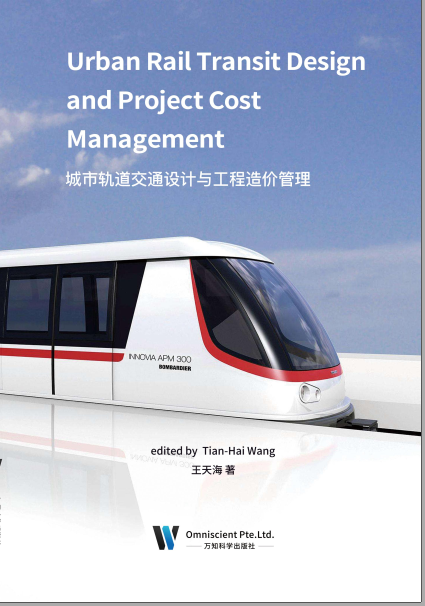
Preface
Urban rail transit is an important part of public transport system in urban infrastructure. From the perspective of the practice of urbanization process in various countries, rail transit has become the main urban transport tool in developed countries and regions by virtue of its technical advantages of large volume, fast speed, safety, reliability, punctuality and comfort, which is popular with citizens. In our country, Beijing, Shanghai, Guangzhou, Chongqing, Shenzhen and other cities also have a considerable scale of rail transit lines. Rail transit has gradually become the preferred means of transportation for residents to travel, and has become the main means for the government to implement the “public transport priority” policy. Vigorously developing urban rail transit has become the general consensus of the government and the public.
The construction and operation of urban rail transit can promote the development of industry, transportation, real estate and other related industries, stimulate employment, promote the appreciation of land along the way, expand the urban development space, and have obvious external economy. Moreover, with the social development, population growth, road network expansion and service level improvement, urban rail transit will attract more passenger flow and its affiliated operation assets have great potential for appreciation. At the same time, the urban rail transit network has the attribute of scale economic circle, and the radiation influence scope covers most areas and surrounding areas in the network. When urban rail transit forms network operation, as a comprehensive network platform, other kinds of networks (such as transportation network, service network, business network, etc.) can be included in it. The strong aggregation and release effect of rail transit network makes the resources and services such as passenger flow, logistics, capital flow and information flow in the network circulate rapidly in all regions of the city and even among cities, changes the consumption, life and production mode of the society, and has a profound impact on the economic operation of the city.
Because of its social and economic attributes, urban rail transit has become the focus of urban transport development strategy, and also regarded as the backbone of urban transport system. Therefore, the Chinese government proposes the policy of “scientifically formulating the technical route of urban rail transit, standardizing the construction standards, orderly promoting the construction of urban rail transit networks such as light rail, subway and tram”, and lists urban rail transit equipment as a strategic emerging industry innovation and development project. In the development process of urban rail transit, many innovative technologies and advanced construction and management methods have emerged, which effectively solve the practical problems in urban rail transit planning, construction, operation and management, and also promote the establishment of China’s urban rail transit policies, regulations and standards system.
Because the new technology of urban rail transit involves many contents, the length and content of teaching materials are limited, the compilation time is relatively short and the level of compilers is limited, there are inevitably some defects in the organization of the content structure of the book and the selection of literature materials. Peers, experts and readers at home and abroad are welcome to criticize and correct it.
前 言
城市轨道交通是城市基础设施中公共交通系统的重要组成部分。从各国城市化进程的实践来看,轨道交通凭借运量大、速度快、安全可靠、准点舒适等技术优势,在发达国家和地区成为主要的城市交通工具,备受市民欢迎。我国北京、上海、广州、重庆、深圳等城市也拥有相当规模的轨道交通线路,轨道交通现已逐步成为居民出行的首选交通工具,也成为政府推行“公交优先”政策的主要手段,大力发展城市轨道交通已成为政府和民众的普遍共识。
城市轨道交通的建设及运营能促进工业、运输、房地产等相关产业的发展,刺激就业,促进沿途土地升值,拓展城市发展空间,具有明显的外部经济性,而且随着社会发展、人口增加、路网扩大以及服务水平的提高,城市轨道交通将吸引更多的客流,其附属的经营性资产具有巨大的升值潜力。同时,城市轨道交通网络具有规模经济圈的属性,辐射影响范围覆盖网内大部分区域和周边区域。当城市轨道交通形成网络化运营后,作为综合性的网络平台可将其他各种网络(如交通运输网、服务网、商贸网等)都载于其间。轨道交通网络强大的聚集和释放效应使网内的客流、物流、资金流、信息流等资源和服务在城市各区域乃至城市间快速流通,改变社会的消费、生活和生产方式,对城市经济运行产生深远影响。
城市轨道交通由于自身所具备的社会属性和经济属性,使之成为城市交通发展战略的重点,同时也被视为城市交通体系的骨干力量。因此,我国政府提出“科学制定城市轨道交通技术路线,规范建设标准,有序推进轻轨、地铁、有轨电车等城市轨道交通网络建设”的政策,并将城市轨道交通装备列为战略性新兴产业创新发展工程。在城市轨道交通的发展过程中,涌现了很多创新技术及先进施工、管理方法,有效地解决了城市轨道交通规划建设、运营和管理中的实际问题,也促进了我国城市轨道交通政策、法规和标准体系的建立。
由于城市轨道交通新技术涉及内容较多,而教材篇幅内容有限,加之编写时间比较紧,且编写人员水平有限,在全书内容结构的组织及文献材料的取舍方面,难免有不妥之处,敬请国内外同行、专家及各位读者批评指正。

Tian-Hai Wang, male, senior engineer, born in Shanghai in September 1978. He graduated from Tongji University with a bachelor’s degree in engineering management and a master’s degree in engineering. He first served as the head of the Jiangxi branch of a cost consulting company and the manager of the consulting department. He has professional technical qualifications such as national registered cost engineer, first-level construction engineer, and British royal quantity surveyor. For many years, he has been engaged in the cost consulting work of rail transit engineering projects and other related fields. The major construction project that participated in, the construction-Nanchang Rail Transit Line 1, won the “2016-2017 National Quality Engineering Gold Award”. At the same time, he led the team has won the first place in the evaluation of owners of the Rail Transit Group for many times. At present, the author is devoted to summing up and analyzing the cost of the professional field of rail transit from a new perspective and a new height, and then forming a unique set of management theories.
王天海,男, 1978 年 9 月生,上海人,毕业于上海同济大学,工程管理专业本科学历,工程硕士学位,高级工程师,先任职于一家造价咨询企业的江西分公司负责人及咨询部门经理;拥有国家注册造价工程师、一级建造师、英国皇家工料测量师等专业技术资格。多年来,一直从事轨道交通工程项目等相关领域的造价咨询工作,参建的重大工程项目——南昌轨道交通一号线获得了“2016-2017 年国家优质工程金质奖”;同时,带领团队多次获得轨道交通集团业主的评比第一名。目前,致力于对轨道交通专业领域的造价从新视角和新高度的总结分析,进而形成一套独特的管理理论。